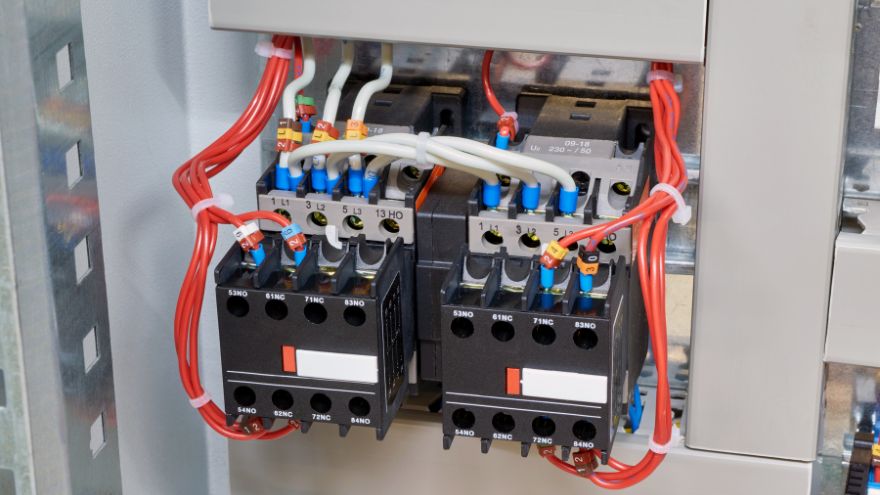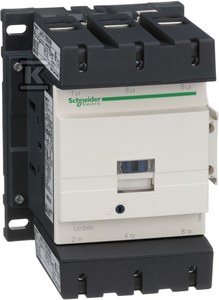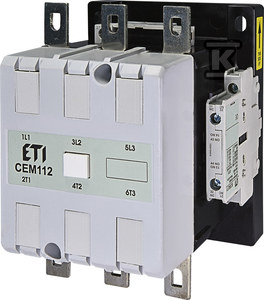A contactor is an electrical switching device that is widely used in the electrical industry to control electrical circuits. It is a key element in electrical installations that allows you to control the flow of current through electrical devices or circuits. What is a contactor? How is it different from a relay? We discuss these and other issues related to contactors in a new article.

Check out electrical contactors at the Onninen wholesaler
What is a contactor?
![electric contactor EATON I=250A [AC-3] 2Z 2R DILM250/22(RA250)](https://onninen.pl/lib/images/208201_EATON_m.jpg) A contactor is an important element of electrical equipment. It enables switching on, off and conducting current in electrical circuits. Importantly, it can perform its tasks both with normal circuit operating parameters and with overload. It is an electrical mechanical switch that operates in a different way than manual operation. The 24V contactor has one rest position of movable contacts and consists of several elements: an insulating base, a fixed core, a contactor coil, a movable electromagnet armature, contacts (movable, fixed, closed and closed) and contact springs.
A contactor is an important element of electrical equipment. It enables switching on, off and conducting current in electrical circuits. Importantly, it can perform its tasks both with normal circuit operating parameters and with overload. It is an electrical mechanical switch that operates in a different way than manual operation. The 24V contactor has one rest position of movable contacts and consists of several elements: an insulating base, a fixed core, a contactor coil, a movable electromagnet armature, contacts (movable, fixed, closed and closed) and contact springs.
Since an electrical contactor must function reliably in all situations, its design must meet the appropriate requirements. Its most important feature is adequate mechanical durability combined with low weight and compact size. Contactors are available in various configurations - including modular contactors - which allows them to be flexibly adapted to various needs. Besides, you can find 1-phase contactor or 3-phase contactor in the market , models with different voltages (e.g. 230V contactor ), power and technical features (e.g. 40A contactor or 25A contactor ). Individual models can be mounted on a DIN rail or mounting plate, which facilitates integration in various applications.
What is the difference between a contactor and a relay?
 The basic difference between a contactor and a relay is their purpose and load capacity. Contactors are designed to switch high-current systems. They are used, for example, in systems powering electric motors, heaters, pumps, sirens, lamps, fans and other high-power devices. In turn, relays are used to transmit low-current signals or signals with zero potential, and their current carrying capacity is much lower than that offered by, for example, a bistable contactor .
The basic difference between a contactor and a relay is their purpose and load capacity. Contactors are designed to switch high-current systems. They are used, for example, in systems powering electric motors, heaters, pumps, sirens, lamps, fans and other high-power devices. In turn, relays are used to transmit low-current signals or signals with zero potential, and their current carrying capacity is much lower than that offered by, for example, a bistable contactor .
Contactors are larger than relays and have additional devices for extinguishing the electric arc. The contact switching time of a contactor may be longer than that of a relay, which may be important in some applications. The difference between contactors and relays is also visible in the noise level, which is usually higher in the case of the former.
In what situations is a contactor useful?
The contactor is used in many situations - especially where it is necessary to control high-power electric motor circuits. Modular contactors , which can be easily integrated with other components of electrical installations, are often used in residential buildings, offices and industrial installations.
One of the key advantages of contactors is their ability to connect capacitive and inductive loads. With available accessories such as auxiliary contacts and electronic timers, the functionality of the contactors can be further enhanced. Additionally, the TSM 1 contactor ensures galvanic separation between the contact circuit and the coil circuit, which has a positive effect on the operational safety of the installation.
Contactors are also irreplaceable in situations where high starting currents occur and the coil inductance may require the use of an intermediary element - for example, a relay or a smaller contactor. The 12V contactor is also used in applications where it is necessary to precisely control electrical circuits in accordance with specific time or speed criteria.
Contactors at the Onninen wholesaler
Due to the great impact contactors have on the proper operation of the installation, only high-quality elements should be selected when designing and installing. You can find reliable contactors with various parameters at the Onninen electrical wholesaler .
 In installations where long service life with limited dimensions is a priority, we recommend using the EATON I=250A [AC-3] 2Z 2R DILM250/22(RA250) electric contactor . Touch protection with an EN50274 compliant terminal cover ensures safe use, and top-quality components ensure durability. The Eaton contactor withstands at least 10 million mechanical switching cycles.
In installations where long service life with limited dimensions is a priority, we recommend using the EATON I=250A [AC-3] 2Z 2R DILM250/22(RA250) electric contactor . Touch protection with an EN50274 compliant terminal cover ensures safe use, and top-quality components ensure durability. The Eaton contactor withstands at least 10 million mechanical switching cycles.
The Schneider Electric I=150 A (AC-3), 1NC+1NO, 110 V AC electrical contactor offers a coil voltage of 110 V AC. Thanks to this parameter , the Schneider Electric contactor works perfectly even in the most demanding applications. In turn , the ETI CEM112.22-230V-50/60Hz electrical contactor offers very good switching parameters, high mechanical and electrical durability and access to universal auxiliary contacts suitable for all contactors. In addition to these models, we offer a wide selection of other devices - e.g. ABB contactor .
Thanks to their advantages, such as the ability to combine capacitive and inductive loads and the availability of various types, contactors are an important element of industrial automation and electrical installations. Selecting a model appropriate to a given application will allow for a reliable and fully functional installation.